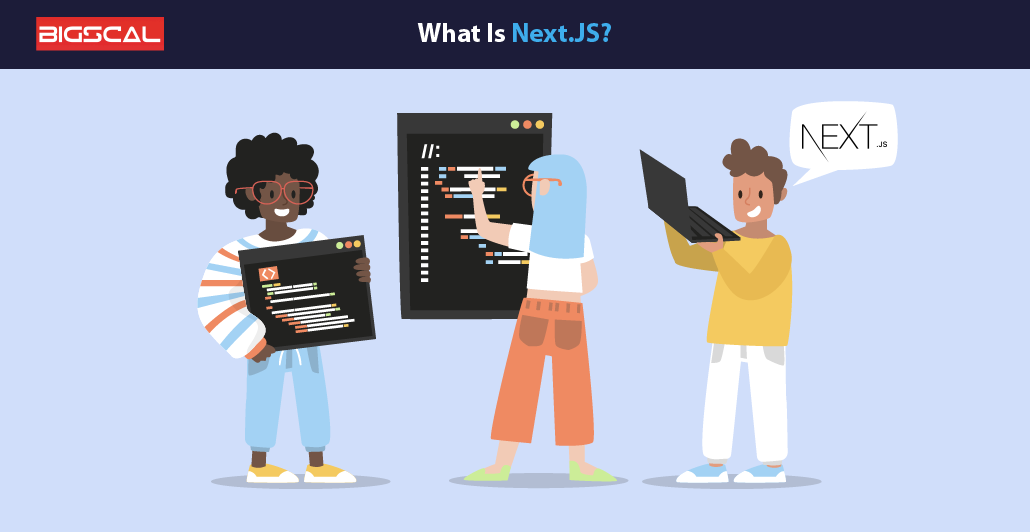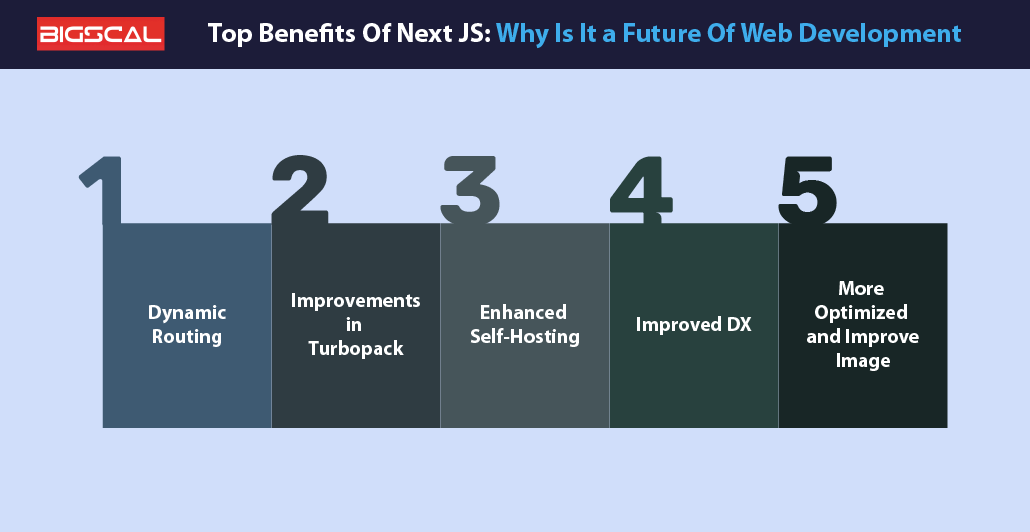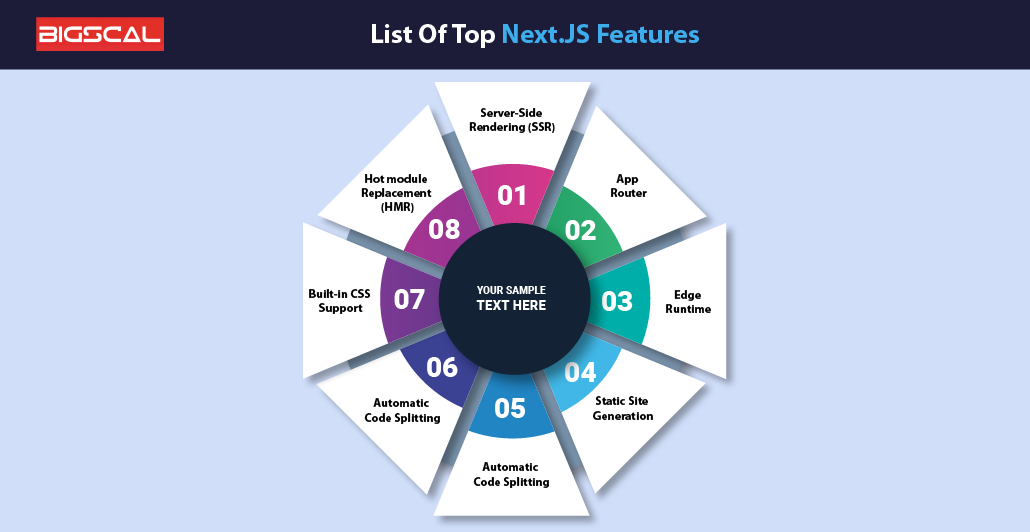Top Next.JS Features and Benefits for 2024
Quick Summary: Are you someone who is considering Next.JS for your software development project? If yes, then go through this blog. Before initializing the project and selecting NExt.js, It is important to know about how it will benefit your project. As we will Discuss the Top Next.JS Features and Benefits. So, keep reading!
Introduction
Do not get shocked, if we tell you that Next.JS is still a top choice for web development even in 2024. Next.js is still in demand for its ability to streamline the development process and provide efficient capabilities for building high performative web applications. With its various updated versions, Next.JS features and benefits are also enhanced.
So, It’s important to take a closer look at the advancements in Next.JS for 2024 . Staying updated with the latest tools and frameworks is essential to building modern, efficient and scalable web applications. And if you are someone who is about to approach it then this article is for you.
So, if you are someone who is about to approach it Or, you’re an experienced developer, or a newbie eager to explore the latest tools in web development. Then this article is for you. It will provide valuable insight into why it is still a top choice for development.
In this article, we’ll provide an Introduction To Next.Js basics. Also, explain to us about our professional help. So check how they improve the web development experience.
Read on!
What Is Next.JS?

Next.JS is a framework of React. You might know it when you have read about the react js vs next js.
It greatly simplifies the process of web development. With these tools and this type of resources Web becomes active, vivid and takes into account search engines. Besides that, Next.js comes equipped with static site generation techniques.
In addition, developers also prerender pages during build to increase the speed of output. It is not only with features such as automatic code splitting, hot module replacing, as well as TypeScript support. that all increase the quality and the productivity of the developers.
Besides, having Next.js developers do such tasks can be a lot easier compared to dealing with complicated layouts or setup. In this way, its simple and considerate API as well as detailed documentation make it a good choice for everybody, from beginners to sophisticated developers, as they can develop modern web apps efficiently.
Top Benefits Of Next JS: Why Is It a Future Of Web Development

Next.js, as a React framework, is constantly improving, promising a future of better and more robust web development. Hence, with every new version, developers can expect more improvements, scalability, and enhanced developer experience.
So, before diving deeper into this guide, let’s first understand how the new version of Next.JS that is, Next.JS 14 or 14.1. enhancing the web development with its improvements:
Dynamic Routing
The latest next.js version will allow developers with dynamic routing capabilities. Additionally, it provides them a dynamic, SEO-friendly URL design. This feature provides easy access to web applications and improves the overall user experience.
Improvements in Turbopack
A feature introduced in Next.js, Turbopack, aims to improve application performance through intelligent integration of JavaScript code. Improvements to Turbopack with each update ensure faster load times and more efficient resource utilization.
Enhanced Self-Hosting
Next.js automatically prioritizes hosting capabilities. It enables developers to deploy applications quickly. Enhanced self-hosting features simplify the deployment process. It gives developers more control and flexibility over their hosting environment.
Improved DX
Next.js focuses on enhancing the developer experience by providing intuitive APIs, complete documentation, and useful tools. It improves error texts, fast refresh, and server actions on client side. Additionally, these improvements make it easier for developers to build, test, and deploy web applications more efficiently.
More Optimized and Improve Image
In the latest version of Next.JS it supports more high quality use cases. It ensures faster load times and better performance. With each iteration, Next.js improves image handling. It provides developers with more tools and techniques to optimize image delivery and enhance user experience.
List Of Top Next.JS Features

Server-side rendering (SSR)
Next.js consistently excels in server-side rendering capabilities. SSR supports for dynamic content creation on a per-request basis. It increases productivity and optimizing SEO. With SSR, the server generates HTML for each page requests command.
Hence, it ensure that users receive fully rendered pages with minimal client-side processing. Additionally, this feature is especially useful for heavy websites or applications where SEO is a priority. Hence, as search engine crawlers can easily index content.
App Router
The Next.JS 14.1 has an enhanced router it simplifies navigation in applications. Additionally, the app router handles the client-side routing more efficiently. hence, it provides seamless transitions between pages while maintaining a clean URL structure. Furthermore, it provides more advanced features. These includes, nested routing, dynamic route matching, and pre arrival.
All these elements enhance the user experience. Moreover, developers can easily define routes and handle navigation events. This makes it easy to build complex single-page applications (SPAs) or multi-page applications (MPAs) with Next.js.
Edge runtime
Another exceptional Next.JS Features is that it introduces the Edge Runtime environment. It uses edge computing to improve application performance and reliability. By running code closer to the end user, Edge Runtime reduces latency. And it ensures faster response times. It also provides a built-in caching mechanism and edge-side rendering capabilities. Further, it enhances the scalability and flexibility of Next.js applications.
Edge Runtime integrates seamlessly with popular content delivery networks (CDNs). These allows developers to quickly deploy and maintain their applications while taking advantage of edge computing. This feature has particular advantages for global applications where simple and widely available networks are essential.
static site generation
With its latest version Next.JS provides more efficient static site generation. It allows developers to pre-render pages during build. This means that when a user requests a pages, they immediately receive a fully rendered HTML page, increasing performance and SEO.
Using static site generation, content can be served directly from the CDN. It reduces server load and improving scalability. Next.js supports static and dynamic content generation. Additionally, it provides flexibility for different applications.
Automatic code splitting
Next.js automatically splits code bundles. It optimizes deployment time by simply delivering the necessary JavaScript to the client. This feature is especially useful for large applications. Because it ensures that users download only the code needed for the specific page they are viewing.
Automatic code splitting, increases Next.js performance and improves the user experience, especially on slower networks or devices.
Built-in CSS support
The another captivating feature of Next.JS is built-in support for styling and CSS. This features allows developers to easily add style sheets to their projects. It simplifies the styling process, allowing developers to directly apply CSS files without the need for additional configuration.
Additionally, it includes various techniques. These techniques includes CSS modules and CSS-in-JS libraries such as styled-components. This built-in support streamlines the development workflow. It makes it easier to create beautiful and functional web applications.
Hot module replacement (HMR)
Hot Module Replacement (HMR) A feature in Next.js. It allows developers to insert hot modules into the running application. And for this they do not need to have to create a new one at all. This greatly speeds up the development process by preserving the state of the application as the code is updated.
When a developer makes changes to their codebase. They do not need to reload the whole page HMR executes only the modified modules. It create a faster feedback loop. This feature increases developer productivity and reduces time waiting for the application to be rebuilt.
Serverless functions and API routes
Next.js provides built-in support for serverless services and API routing. It allows developers to build server-side logic without the need for a separate server. With serverless services, developers can handle dynamic content generation. They can also handle validation, and database operations directly within their Next.js application. API methods enable developers to define custom endpoints to handle HTTP requests.
This makes it easier to build RESTful APIs or integrate them with external applications. By using serverless architectures, developers can effectively scale their applications and pay for resources only. For that they do not need to worry about server maintenance or infrastructure management.
Incremental Static Regeneration (ISR)
This is a powerful feature of Next.JS that makes it unique. It combines the benefits of static site generation with dynamic content updates ISR. This allows developers to pre-render static pages during build and it is then refined and updated in runtime. It is based on specified intervals or triggers. This allows websites to serve up-to-date content while maintaining the performance benefits of static site generation.
It allows developers to balance static pages that load quickly with dynamic content updates. Which results in a seamless user experience. This feature is especially useful for content-rich websites, blogs, and e-commerce platforms. The platforms that require frequent updates without sacrificing performance.
Elevate Your Next.JS Project With The Help Of Bigscal Technologies
Do you need professional help to elevate the Next.JS project? If yes, then you must approach Bigscal Technologies.
At Bigscal we offer the best software development services for various types of projects and for multiple domains. With our expertise in Next.JS, we can make your project more efficient, effective and productive. Our team of experienced professionals specialize in Next.js. They can provide valuable insights and solutions to elevate your project to the next level.
So, With Bigscal Technologies by your side, you can be confident that your Next.js project will be in capable hands. We deliver exceptional results beyond your expectations.
Conclusion
So, we hope it’s now clear to you that Next.js is a framework that is full of benefits and exceptional features. And that is the reason why it is always a preferable choice for web development. With every update it introduces new features and improves its current features. All the Next.js features that we include in this blog are of its current version.
Stay tuned for our next blog as we will be about to disclose how you can start developing your own app with the latest version of Next.JS.
FAQ
What are top trends in Next.js development for 2024?
Top trends in Next.js development for 2024:
- Hybrid rendering
- More focus on accessibility
- More enhanced developer experience
- Improved features
- Increasing demand
Top Uses of Next.JS?
One can use Next.JS for:
- Building Ecommerce applications
- Creating Websites like Wikipedia
- For developing booking apps
- Building sites for auction
- For creating PWA
What is the key difference in React and Next.JS?
The main difference between React and Next.JS is:
React is a JavaScript library that is useful for creating user interfaces. On the other hand, Next.JS is a framework provided by React.
Can I use Next.JS for building enterprise applications?
Yes, you can use Next.JS for building enterprise applications. It provides scalability, excellent performance, built-in features like server-side rendering. Additionally, it supports handling complex applications and data.
Why Next.JS is best for building web apps?
Next.JS is best for building web apps due to various reasons and these are as follows:
- It is SEO friendly
- High Performance
- Best experience for developers
- It is versatile
- Quick image loading
- Faster refresh feature





